Ultimate working prepper pantry list with tips and guide for how to stockpile food and household items, both for survival and everyday use. Learn how to organize and store items, so your family is ready for whatever situation you face, whether it's an emergency, illness, or natural disaster. Free printable checklist!
For a long time, Dan and I have both wanted to spend some time stocking our survival pantry and household supplies that have a long shelf life. We've always stockpiled to a small degree, but we've wanted to take it further.
One thing or another has kept us from really jumping all in, whether it's keeping our finances in order or actually having the time to plan and implement.
Like I said, I've always had this tendency to keep a little stockpile of things we use on a regular basis. I'm pretty sure my growing up on a farm has a lot to do with my habits, and I count that as a good thing.
Why Everyone Needs a Preppers Pantry
There are so many reasons to keep a working pantry full of survival foods and household supplies you use on a daily basis.
- An illness could keep you stuck at home for awhile.
- A natural disaster scenario with widespread power outages.
- Think spring storms with the threat of power outages.
- You or your significant other could experience a job loss.
- It's possible we could experience food shortages in the near future.
You name it, a prepper's pantry is a really good idea all 'round. We've personally experienced power outages, job loss, and illnesses that have kept us from getting out to the store. Life happens, and it's good to be prepared, so your family has peace of mind and enough food to last an extended period of time.
So how can you get started, and what kinds of things do you need to stock up on? What even is a working pantry? And how do you do all this on a budget? I'm going to answer all of these questions and more as you keep reading.
You'll also find a FREE PRINTABLE PREPPER PANTRY LIST and a VIDEO OF OUR OWN WORKING PANTRY toward the bottom of this post.
Need to know how to make a weekly meal plan from your pantry? <– I've gotcha covered!
What Is a Working Prepper Pantry?
First you need to know the difference between a working pantry and an emergency pantry. And then you can decide which is right for you.
An emergency pantry is basically a side stash you collect for emergency situations and emergency use only. Many prepper pantries function like this.
A working pantry, on the other hand, is a pantry you stash with all the foods and supplies you use on a regular basis, and you use a rotation system, so nothing is wasted.
By rotation system, I mean you're constantly pushing older things to the front and putting new replacement items in the back, so older foods are used up first.

We've always kept a working pantry, and we knew right from the start, that's the kind of pantry we wanted to continue to build. With family members that have special dietary needs, like diet-controlled diabetes and a gluten intolerance, it's important that we stock the kinds of foods we can eat without literally dying or living in misery.
We also didn't want to waste one can, one crumb, or one nutritious morsel of food. When we're constantly rotating and using the foods we collect, that pretty much ensures that nothing will go to waste.
How to Stock a Pantry for the First Time
How to even get started and how to stock a pantry on a budget are both questions that demand answers when you're just getting started.
Getting started is easy as long as you have paper and pencil. I actually have a little notebook (or Field Notes) I use, as well as my Notes app on my phone. Both help me keep track of what we need to continuously stock and things that are running low.
Go through your cabinets, as well as your fridge and freezer. Compile a list of all the foods and supplies you use on a regular basis.
I'm talking food and non-food items, including meats, vegetables, dry ingredients, spices and seasonings, medicines, cleaners, paper products, water, other drinks, essential oils if you use them, etc.
Even if some of the foods are frozen, you may be able to start collecting things that are shelf-stable in their place. For instance, frozen/fresh chicken… You can start collecting canned chicken in its place (or better yet, can your own).
Think about how much food and supplies your family use in any given week, and write that number down next to the item. Multiply that by the number of weeks in a month, and you know how much you need for a month's supply, which in turn, will help you figure out how to stock a pantry for a year.
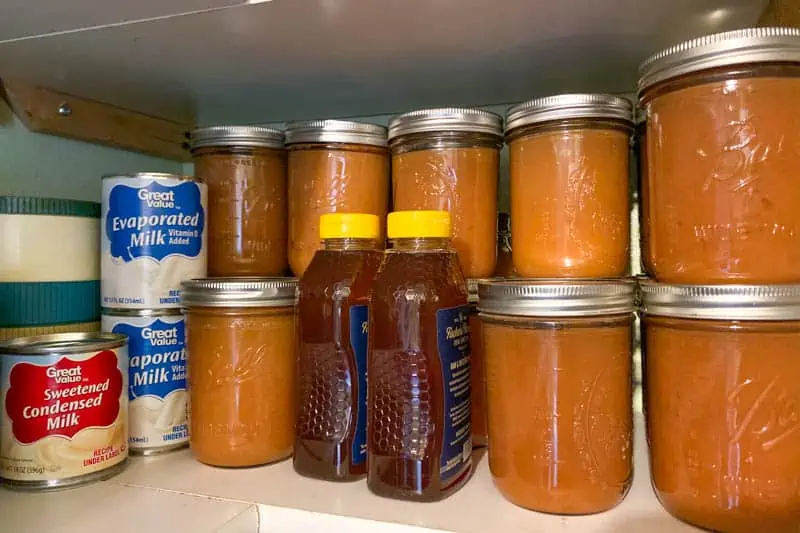
Building a well-stocked prepper pantry may seem overwhelming at first, but just take baby steps. Speaking of which…
How to Stockpile on a Budget
Whether you're trying to stock up on a budget, or you've come into a windfall of extra money, there are specific ways you can scrimp and save to make the process less painful on your bank account.
- Take a small part of your weekly grocery budget, and dedicate it to stocking your pantry.
- Shop at Aldi or other grocery discount stores. We find some of the best deals on canned food at Aldi.
- Watch sales and BOGO offers at ALL your local grocery stores. This will require going to more than one local grocery store.
- Watch instant savings or discounts at big box club stores, like Costco and Sam's Club. They often have sales, where if you buy so many of one item, you acquire a significant discount.
- Compare Amazon Prime Pantry prices to local prices. Our oldest, Jacob, makes all his own bread, and one way I've found to more affordably get his bread flour (when it's in stock), is to order a Pantry box from Amazon.
- Use coupons if you can get your hands on them.
- While I haven't personally tried this, my neighbor sometimes finds “damaged” deals on Amazon, where she'll get a big package of something that has been slightly damaged, but still usable, and is significantly discounted.
- If you get a Christmas bonus or a tax refund, or maybe you're self-employed and have a really good month… Take a small part of those earnings, and invest them. I say invest because this truly is an investment into your own, as well as your family's, health and well-being.
- Sell something to stock your pantry. Just about everyone has things just lying around the house they could likely sell that would help them get a good start.
- Think about food preservation strategies you can implement. You can also garden and grow food to can, but gardening takes money too.
It's important to figure out what will work for you and your family without causing undue strife or stress.
And now we get to the meat of this post (no pun intended).
What Foods Should You Store for Survival?
Now your list of foods may look slightly different from mine because of our family's partial dietary needs (diet-controlled diabetes and a gluten intolerance). But for the most part, the foods on this list are survival foods every prepper should have in their pantry.

Think long-term and shelf-stable. You want to stock basic pantry staples, essentials, and foods that last the longest.
Meats and Proteins
You can purchase different types of canned meats over time, or you can actually preserve and can your own beef, deer meat or venison, chicken, etc.
- Canned chicken
- Tuna
- Canned salmon
- Spam
- Vienna Sausages
- Learn how to can ground beef and other meats like venison.
Vegetables and Fruits
- Canned vegetables – We keep a steady supply of green beans, spinach, beets, peas, a few cans of mixed vegetables, a little bit of corn, etc.
- Crushed tomatoes – Great for making sauces and soups.
- Canned fruits – Pears, mandarin oranges, peaches (perfect for peaches and cream oatmeal), pineapple, etc.
Beans and Legumes
- White rice – White rice will keep almost indefinitely, so it's a much more shelf-stable food to choose over brown rice, which will only keep for up to six months.
- Dry beans – Again, we don't eat a ton of rice and beans, but it's always good to have a supply of both because they're very sustainable.
Fats
- Olive oil
- Coconut oil
- Other types of oils you may use.
Spices and Seasonings
- Sea salt
- Ground black pepper
- Seasoning salt
- Any other types of seasonings you use and enjoy, including and especially Badia seasonings.
Grains and Flours
- Flour, including my favorite gluten-free flour (or ingredients to make your own gluten-free flour with a grinder)
- Cornmeal
- Oats
- Cereal – About the only cereal I keep in stock is Cheerios.
Baking Ingredients
- Xanthan gum
- Baking powder
- Baking soda
- Cocoa powder
- Extracts – Vanilla extract, almond extract, caramel extract, etc.
- Cornstarch
- Sugars – Pure cane sugar or granulated, brown sugar, and powdered sugar
- Honey or other sweeteners
- Active dry yeast
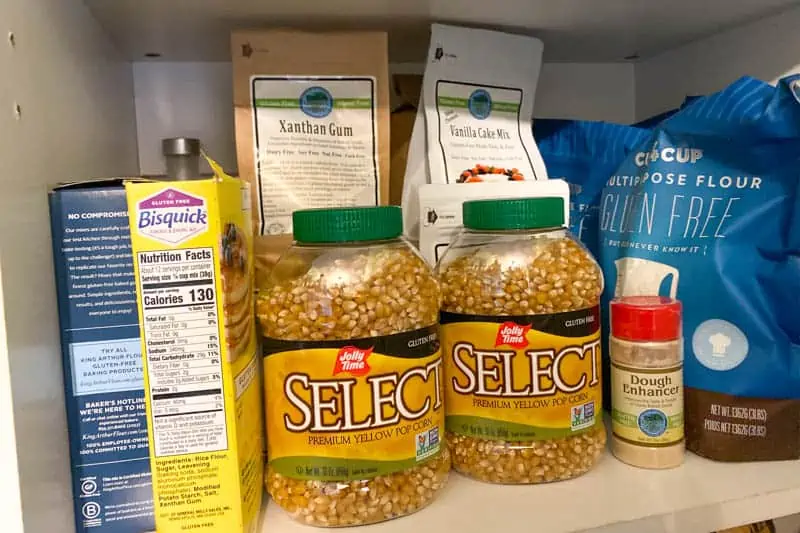
Miscellaneous Foods and Ingredients
- Bullion, broth base, or stock
- Soups – I especially love Amy's Organic Soups, since there are many gluten-free options.
- Pasta – We don't eat a lot of pasta, but I do stock a little bit of gluten-free spaghetti. My kids also love Ramen noodles.
- Potatoes or potato flakes
- Condiments like mayo, mustard, ketchup, Miracle Whip, etc.
- Peanut butter or other nut butters
- Salad dressings – If you're able to grow your own lettuce, this will be nice to have.
- Shelf-stable parmesan cheese
- Taco shells or corn tortillas
- Jams and jellies – I love making strawberry jam, blackberry jam, peach preserves, and apple jelly.
- Applesauce and apple butter
- Maple syrup – Perfect for making maple brown sugar oatmeal or enjoying on pancakes.
- Crackers and Saltines – including gluten-free saltine crackers.
- Nuts – Peanuts, walnuts, pecans, almonds, etc.
- Popcorn
- Simply Cheetohs Puffs – My secret obsession.
- Chocolate – including chocolate chips.
- Pet food – Don't forget your furry friends, or your feathered friends if you have chickens.
Water and Drinks
- Water Supply – Now you don't necessarily have to go out and buy a bunch of water. You can repurpose milk jugs and juice jugs by washing them out thoroughly and filling them with water. You can also fill up un-used canning jars with water and build quite the water supply that way.
- Coffee – Also, powdered creamer if you like cream in your coffee.
- Tea bags
- Hot chocolate mix
- Juice – I stock grape juice because my boys love it, and my oldest craves it if he's sick.
- Ginger ale, Sprite, or other tummy calming drinks
- Propel powder packets – I buy these in case we need to replace electrolytes when sick. They have zero sugar and zero colors.
- Dry milk – I purchase canned dry whole milk, and if we don't end up using it by close to the expiration date, I'll use it in recipes, so it's not wasted.
- Dry buttermilk – Our oldest makes the most delicious gluten-free fried chicken with this.
- Wine or other alcohol
Recipes for Beginning Preppers
Recipes you can make with fresh or canned ingredients, whether you need breakfast, lunch, dinner, or dessert. Swap out fresh for canned, freeze-dried, or powdered ingredients straight from the pantry.
Perfectly Cooked Maple Brown Sugar Oatmeal

Peaches and Cream Instant Pot Oatmeal

Quick and Easy Grilled Taco Tuna Melt

Chicken Fried Rice in a Wok

Delicious Salmon Patties Recipe

Chicken (or Tuna) Salad Sandwich Recipe

Easy Instant Pot Chicken Noodle Soup

Easy Campfire Peach Cobbler Recipe

Buttermilk Oatmeal Cookies

Buttermilk Cornbread

Easy Campfire Drop Biscuits
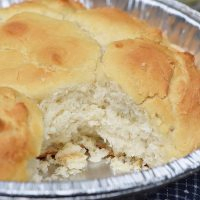
Toasted S'mores Dip

Kitchen Paper Products
- Plastic food storage bags
- Aluminum foil
- Plastic wrap
- Parchment paper
- Wax paper
- Paper towels and paper towel holder – We keep a few, but we're more likely to use our Norwex rags since we've gotten them.
- Trash bags
- Storage containers
Emergency Cookware and Utensils
If you're really serious about prepping, you'll stock certain types of cookware, as well. Probably a lot of things that are on my camping kitchen list.
Things like…
- Water Jugs – We like the jugs with a spigot, since it can act as both water storage and a faucet.
- Water bottles
- Food dehydrator
- Matches or lighter
- Coleman Camp Stove
- Over the fire grill or tripod grill
- Portable charcoal grill with charcoal
- Dutch oven with Dutch oven tripod
- Cast Iron Skillet – Our 10.25-inch cast iron skillet is our go to skillet for just about everything. We also love our larger 12-inch skillet and deep dish skillet.
- Pot holders or welding gloves – These gloves work so much better than ordinary heat resistant gloves.
- Can Opener
- Percolator – Our favorite way to make coffee over the campfire is to cook it the cowboy way, with coffee grains added right into the water. A percolator gives options for making your morning brew.
- Camp stove toaster
- Collapsible wash basin or sink
- Scrubbing pads and wash cloths and quick drying towels
- Campsuds – We keep a big bottle of biodegradable Campsuds at all times. It's perfect for washing dishes and even yourself.
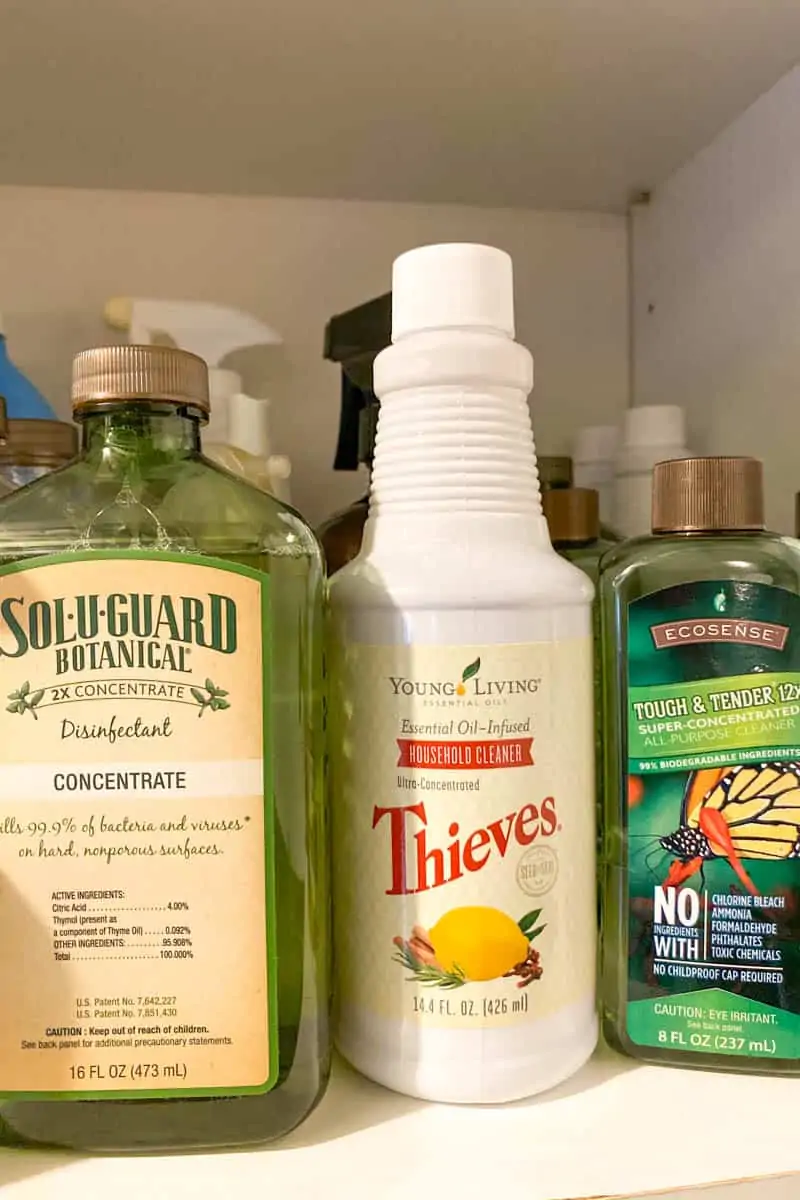
Hygiene, First Aid, and Household Supplies
While I want to focus mainly on food and kitchen in this post, it's also a good idea to think about your entire household, including hygiene items, medical supplies, and household products. To get you started, here are a few suggestions.
- Toilet paper
- Tissues
- Diapers, Pull-Ups, or other items for young children.
- Baby wipes or Body Wipes
- Household Cleaners and Wipes – We typically use our Melaleuca cleaners (Tough & Tender and SoluGuard) or our Thieves Household Cleaner.
- Laundry detergent
- Fabric softener – Or better yet, dryer balls.
- Drying rack – If the power's out, this comes in mighty handy.
- Shampoo and conditioner
- Soap
- Hand soap – We use Dr. Bronner's to make our own. It saves a ton of money.
- Hand Sanitizer
- Deodorant
- Lotion and lip balm – I especially love my Calm & Centered Cream for restless limbs.
- Razors
- Toothpaste, toothbrushes, and dental floss
- Ibuprofen and Acetaminophen – both for adults and kids.
- Mucinex, Oscillococcinum, or other cold medicines
- Allergy meds like Benadryl
- Cough syrup and cough drops
- Activated Charcoal
- Blood sugar test kit/strips
- Rubbing alcohol or alcohol wipes
- Hydrogen peroxide
- Antibiotic ointment, Band-Aids, bandages, and other first aid supplies
- Essential oils and diffusers
- Candles, rechargeable batteries, flashlights, etc.
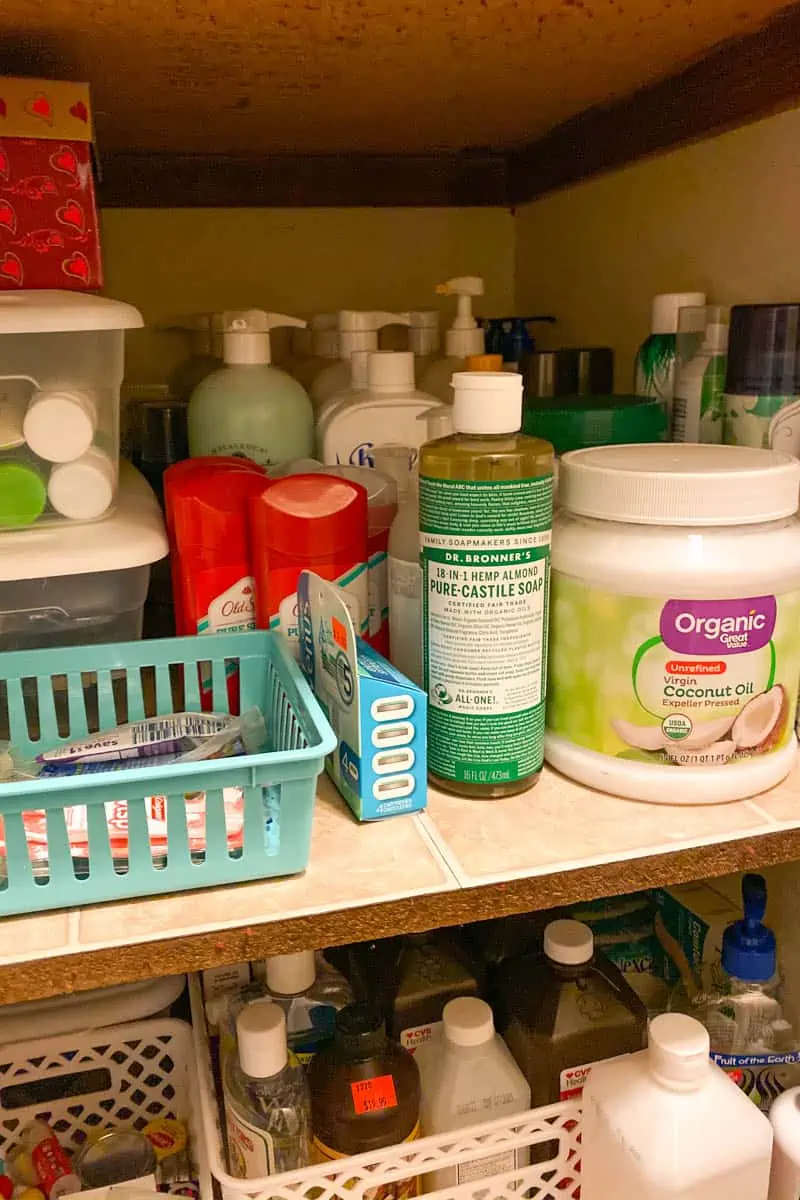
Where to Store Everything
If you have a large house with lots of room, and preferably a basement, you're set. But if you're like us and have a tiny pantry with not much space, you have to be creative.
Instead of thinking, “I don't have room for that”… I want you to think outside the box.
Can you purge and get rid of some things to make more room? Do you have a closet you can clean out and use? What about a dresser drawer or empty shelf? Do you have room underneath beds or a futon? How about an empty tote or bin?
Have a crawl space or an attic? We actually store potatoes we grow in our garden in our crawl space because they keep better in the slightly cooler environment.
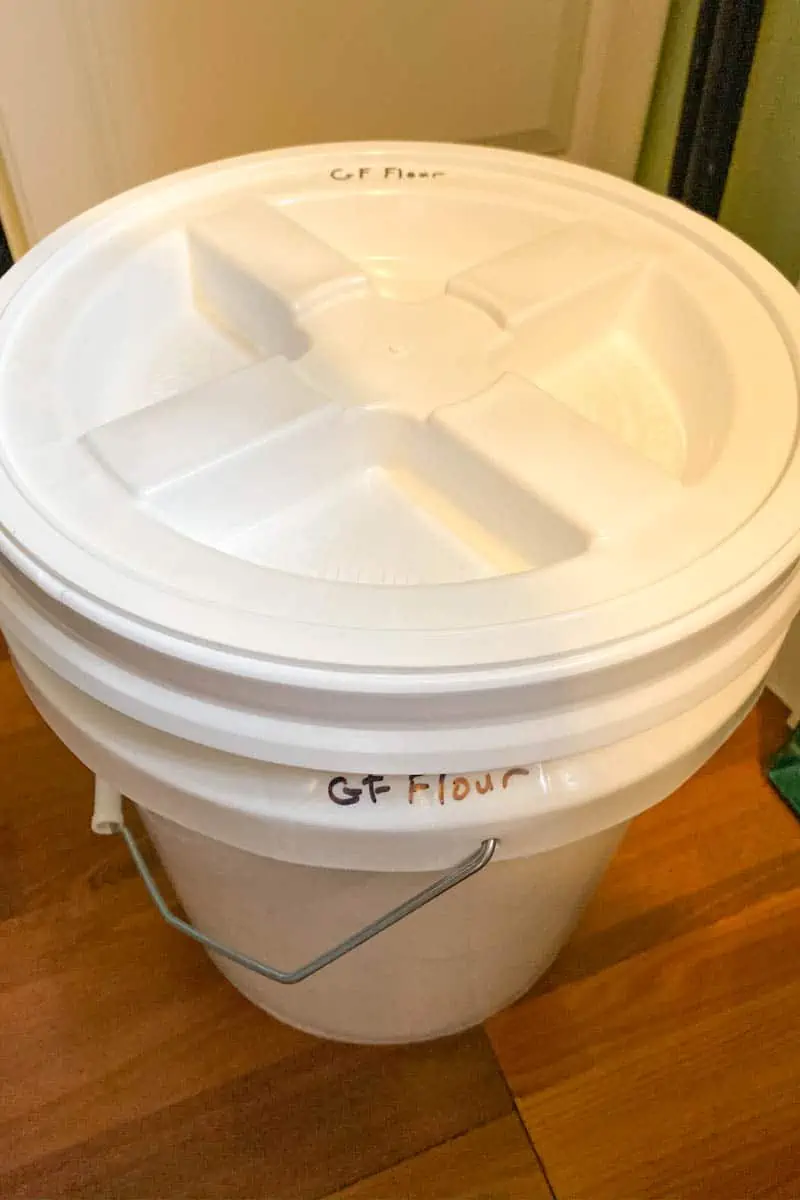
Keep in mind for some of your dry ingredients, you may need food grade buckets with gamma lids or mylar bags for long-term food storage. We usually buy our food-grade buckets at Menards or Lowe's.
Look around your home, and figure out where you can make room and where you can stash supplies for long-term storage. Where there's a will, there's most definitely a way.
Watch Our Video to See How We Stock Our Working Pantry
What to Read Next…
WANT MORE KITCHEN TIPS? Subscribe to my newsletter, and follow along on Pinterest, Facebook, YouTube, and Instagram for all the latest updates!

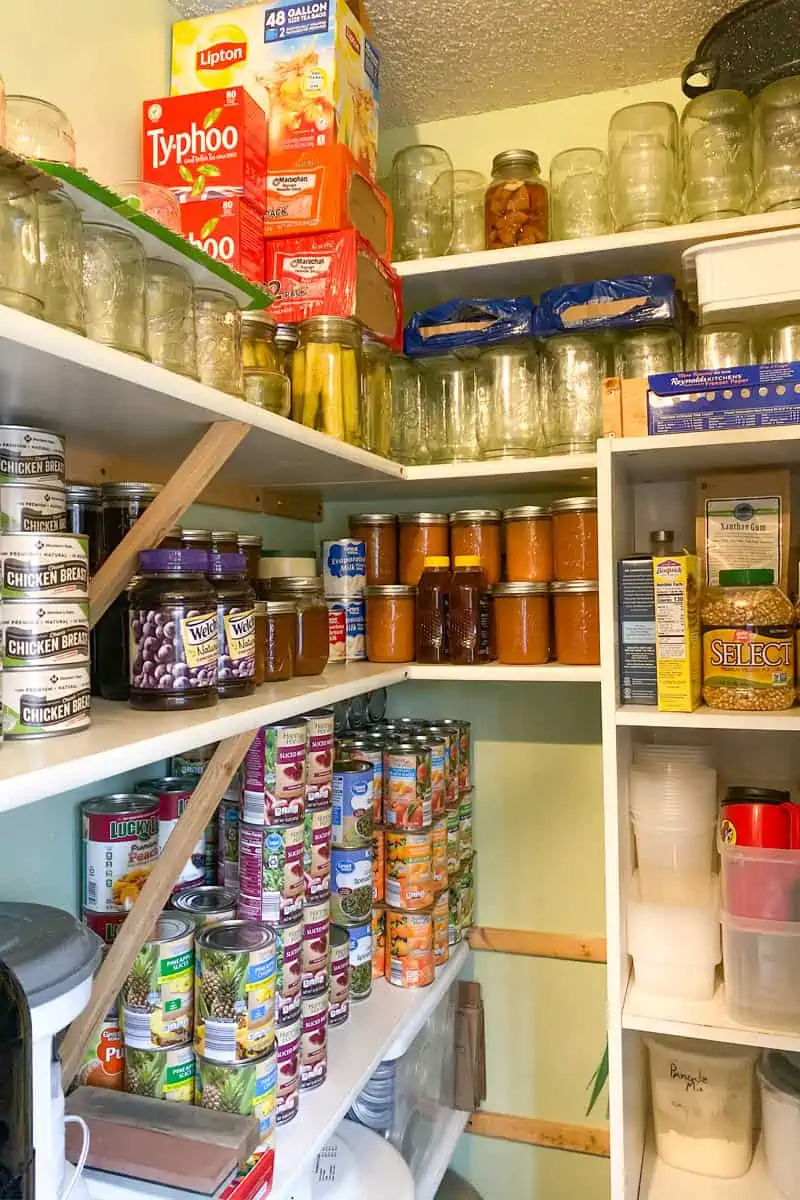











Really enjoyed your pantry list. Have been peeping about 9 months. You gave me a new list of items I overlooked. Thanks so much! But I worry about my stash considering FEMA’S laws about us preppers!! Us hoarders (that’s what we’re called) are a danger to Americans. Any suggestions! My husband and I are a couple of 70 year olds who stay mostly to ourselves and are fearful!! FEMA has authority to confiscate all our supplies and will!! What does a person do??
Hi, I’m sure by now you have received many replies. I’ve been canning most of my 65 years. First with my mom and I was taught how to garden from my father. I doubt that FEMA will be busy with us small time peppers. FYI I’m not a hoarder. To me that gives me a vision of people buying out everything in a crisis. I don’t do that. I buy some of different kinds of things and I never ever take the last item on a store shelf. During a crisis we should be at home and avoiding the craziness that people can cause. I do a lot of canning. I can
ot of canning. Different meats, pasta, rice, beans, canned veggies, and cream of soups, along with condiments that you use. I make and can a lot of soups. The more you do yourself, the cheaper it’ll be. Think different flavors. Mexican, Chinese, barbecue, like that. Also don’t put all your food in one place. You don’t want to alert people that you are stocking up. A couple of cases under your bed, one or two in the corner of closets, if you’re lucky enough to have a basement, box up a dozen or two on your shelves and label them Christmas or cookie cutters, or yard sale items. I watch for sale flyers from my local grocery stores and stock up on food that way. If you eat meat that’s when to buy it, then home can it. You can find jars in thrift stores, yard sales, at your local feed store, even grocery stores or Walmart. Please feel free to respond if you have any questions. Take care.
That sounds like good advice, Sue. Thanks for sharing!
Hi!
Is there a way I can get all of your information in printed form? I’d love to have it for permanent reference as I begin process of pantry storage with recipes. Thanks so much!
Rebecca in Tennessee
Rebecca, the recipe card at the bottom of the post is fully printable. There should be a print icon at the top right of the card. Hope this helps!
Thank you for sharing, I’ve purchased good but could not figure out hot to “manage” it all. Now I have some ideas
I’m glad I could help, Debra. Thanks for the feedback!
I love all of this info! It’s exactly the kind of list my bestie was looking for to start her journey! Thank you!
(Please be careful with milk jugs- no matter how many times I clean them, they’re never drinkable for me and can cause some gastrointestinal distress.)
I’m so glad it helped, Mackenzie! Thanks for the feedback.
This is the most helpful post on prepping I’ve read. I have been so overwhelmed. Thanks!
Kayla, I’m glad that this helped you! Thanks for stopping by.
I didn’t see a place on the video to “subscribe” did I miss it somewhere?
You have to scroll down to my profile icon. You can also visit my channel home page and click “subscribe” in the top right corner.
Many of the food items you listed(Raisins;oatmeal, hot cocoa packets) should be repackaged in vacuum sealed bags.
Great tip, Elbert. Thank you!
I’ve been watching videos and scribbling notes for days and spent many hours doing so. HOWEVER…..I found your amazing site 2am last night and (queen the Angel’s singing) you have everything I’ve been looking for in ONE PLACE!!!! Thank you so much! I will remain a devoted follower forever. God bless you and your family and may you all Stay safe.
Kathleen, thank you so much! I’m so glad I could be of help to you. God bless you and your family, and I pray you stay safe, as well.